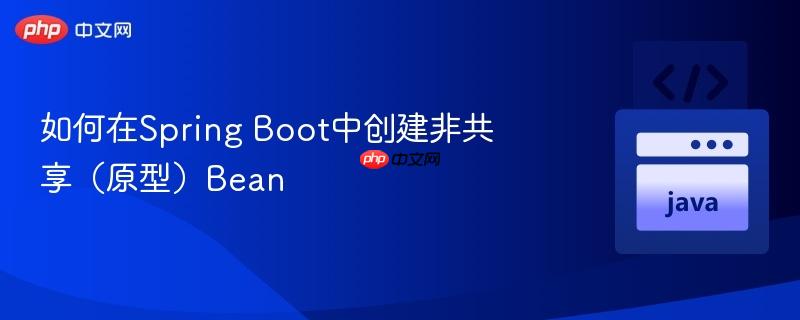
在Spring Boot中,默认的`@Bean`声明会创建单例(Singleton)Bean,即所有注入点共享同一个实例。本文将详细阐述如何通过使用`@Scope("prototype")`注解,为每个注入请求生成独立的非共享(原型)Bean实例。这对于管理像`RestTemplateBuilder`这类具有状态的组件至关重要,以避免因状态共享导致的副作用,确保组件行为的独立性。
在Spring框架中,通过@Configuration类中的@Bean方法声明的组件,其默认作用域是“单例”(Singleton)。这意味着Spring IoC容器只会为该Bean创建一个实例,并在所有需要注入该Bean的地方共享这同一个实例。这种设计模式在大多数情况下是高效且内存友好的,因为它避免了不必要的对象创建。
然而,对于某些特定场景,单例模式可能会引入问题。例如,当一个Bean是“有状态的”(Stateful),即其内部属性会随着业务逻辑的执行而改变时,如果多个组件共享同一个实例,一个组件对该实例状态的修改可能会意外地影响到其他组件,导致难以追踪的副作用。RestTemplateBuilder就是一个典型的例子。它是一个构建器,用于配置RestTemplate实例,其内部可能包含一些构建过程中的瞬时状态。如果所有服务都共享同一个RestTemplateBuilder实例,一个服务对它的配置修改可能会意外地影响到其他服务创建的RestTemplate。
为了解决有状态Bean的共享问题,Spring提供了“原型”(Prototype)作用域。当一个Bean被定义为原型作用域时,Spring容器会在每次注入或通过getBean()方法请求该Bean时,都创建一个全新的实例。这确保了每个使用方都拥有自己独立的Bean实例,从而避免了状态共享带来的潜在问题。
要将一个@Bean方法定义为原型作用域,只需在其上添加@Scope("prototype")注解即可:
import org.springframework.context.annotation.Bean;
import org.springframework.context.annotation.Configuration;
import org.springframework.context.annotation.Scope;
@Configuration
public class AppConfig {
// 假设Person是一个有状态的类,或者我们希望每次注入都得到一个新实例
@Bean
@Scope("prototype") // 声明为原型作用域
public Person personPrototype() {
System.out.println("Creating a new Person instance...");
return new Person("John Doe", 30);
}
// 示例:一个使用Person Bean的组件
// 每次注入PersonService时,它将获得一个全新的Person实例
@Bean
public PersonService personService1(Person personPrototype) {
System.out.println("PersonService1 created with Person instance: " + personPrototype.hashCode());
return new PersonService(personPrototype);
}
@Bean
public PersonService personService2(Person personPrototype) {
System.out.println("PersonService2 created with Person instance: " + personPrototype.hashCode());
return new PersonService(personPrototype);
}
}
// 假设的Person类
class Person {
private String name;
private int age;
public Person(String name, int age) {
this.name = name;
this.age = age;
}
// getters and setters
public String getName() { return name; }
public void setName(String name) { this.name = name; }
public int getAge() { return age; }
public void setAge(int age) { this.age = age; }
@Override
public String toString() {
return "Person{" +
"name='" + name + '\'' +
", age=" + age +
'}';
}
}
// 假设的PersonService类
class PersonService {
private final Person person;
public PersonService(Person person) {
this.person = person;
}
public void doSomething() {
System.out.println("Service using person: " + person.getName() + ", hash: " + person.hashCode());
}
}在上述示例中,每次Spring容器需要注入Person类型的Bean时(例如注入到personService1和personService2中),都会调用personPrototype()方法,从而创建一个全新的Person实例。通过观察控制台输出的哈希码,可以验证personService1和personService2注入的是不同的Person实例。
除了直接使用字符串"prototype",你也可以使用ConfigurableBeanFactory接口中定义的常量来指定作用域,这通常被认为是更健壮和可读性更高的方式:
import org.springframework.beans.factory.config.ConfigurableBeanFactory;
import org.springframework.context.annotation.Bean;
import org.springframework.context.annotation.Configuration;
import org.springframework.context.annotation.Scope;
@Configuration
public class AnotherAppConfig {
@Bean
@Scope(value = ConfigurableBeanFactory.SCOPE_PROTOTYPE) // 使用常量定义原型作用域
public MyStatefulObject myStatefulObjectPrototype() {
System.out.println("Creating a new MyStatefulObject instance...");
return new MyStatefulObject();
}
}
class MyStatefulObject {
// ... 类的定义
}ConfigurableBeanFactory.SCOPE_PROTOTYPE常量与字符串"prototype"具有相同的功能,但它提供了编译时检查,避免了因拼写错误导致的运行时问题。
原型作用域并非万能,它有其特定的适用场景:
通过@Scope("prototype")注解,Spring Boot开发者可以灵活地控制Bean的作用域,从默认的单例模式切换到原型模式。这对于管理有状态的组件、避免副作用以及确保组件行为的独立性至关重要。理解不同Bean作用域的特性及其适用场景,是构建健壮、可维护Spring Boot应用的关键。在选择Bean作用域时,务必权衡性能开销和生命周期管理的复杂性,以做出最适合应用程序需求的决策。
以上就是如何在Spring Boot中创建非共享(原型)Bean的详细内容,更多请关注php中文网其它相关文章!

每个人都需要一台速度更快、更稳定的 PC。随着时间的推移,垃圾文件、旧注册表数据和不必要的后台进程会占用资源并降低性能。幸运的是,许多工具可以让 Windows 保持平稳运行。




Copyright 2014-2025 https://www.php.cn/ All Rights Reserved | php.cn | 湘ICP备2023035733号